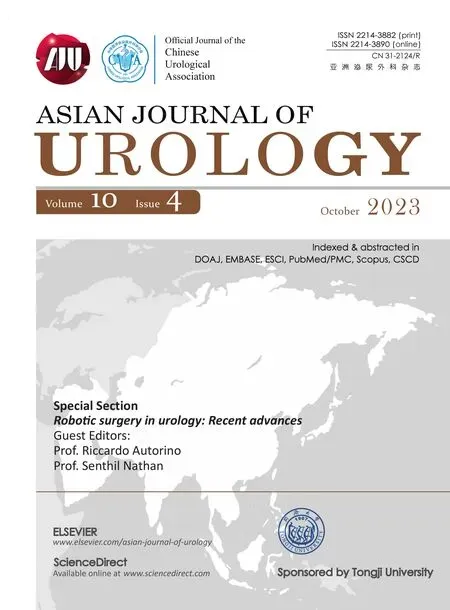Utility of three-dimensional virtual reconstruction for robotic-assisted partial nephrectomy using the IRIS?
In this issue of Asian Journal of Urology,the study by Ghazi et al.[1] presented the clinical utility and fidelity of three-dimensional (3D) virtual reconstruction (VR) using the IRIS?(Intuitive Surgical?, Sunnyvale, CA, USA) for robotic-assisted partial nephrectomy (RAPN).By using preoperative and postoperative questionnaires, the authors were able to determine the ability of this software to predict intraoperative anatomical findings as well as correlation between planned surgical approach and actual surgical approach.They found good overlap between planned arterial clamping and executed clamping (85%-90%).Additionally, the performing surgeons described various features of the IRIS?software that were useful in delineating spatial anatomy, specifically pan and rotation as well as alternating transparency features,reaching 100%ratings for nephrometry scores 7-12.This is not the first study in the literature examining the role of 3D-VR in RAPN.There has been an exponential growth in recent years on the indications for and outcomes of 3D-VR [2].That being said, the current study adds another dimension to the existing literature on the topic.
The authors derived three conclusions from this study:1)the IRIS? 3D-VR software can be utilized for patient counseling and surgical planning; 2) the software can be easily accessible intraoperatively to aid in spot decision making; and 3) increased utilization of IRIS?can be used for resident and fellow training.With regards to the first point, the authors demonstrated good fidelity between planned clamping technique and performed technique.There was 84.6%fidelity with primary renal artery clamping and 90% with off-clamp and selective clamping.There was not as impressive correlation between preoperative plan for secondary or tertiary artery clamping and what was performed intraoperatively (70% and 75%, respectively).While clamping status demonstrated some heterogeneity,the participating surgeons did attest to high fidelity in identification of relevant anatomy.This lends credence to the notion that the software can be safely used for surgical planning.While the authors did not specifically delve into aspects of patient counseling,it is conceivable that surgeon confidence in surgical approach can then translate to more directed patient counseling and set expectations.
One of the most relevant features for IRIS?is the ability to toggle using TilePro.This allows ease of accessibility of 3D images,with overlay in the operative field.The advantage of this was demonstrated in the frequency by which surgeons accessed the reconstructed imaging, referring to IRIS?intraoperatively more than 10 times in 50% of high complexity cases.This is a valuable tool to have in the operating room for spot visualization of challenging anatomy and provides the surgeon another vantage point for intraoperative decision-making.Indeed,partial nephrectomy is a procedure that is uniquely suited to intraoperative supplementary imaging [3].Intracorporeal ultrasound is routinely used for more precise delineation of tumor location prior to excision.Firefly technology and other fluorescent imaging techniques have been used to identify vasculature as well as viable parenchyma post resection [4].Artificial intelligence software has become increasingly employed as well to predict intraoperative and postoperative events [5].The IRIS?software is just another tool in the armamentarium of the urologist performing RAPN.
Given the highly rated intraoperative planning ability,the authors touched upon another salient point in how IRIS?can be used to enhance training.Review of preoperative imaging, with identification of tumor location,depth, as well as renal vascular anatomy, is the crucial teaching point for trainees and represents the first step prior to “hands on” involvement with the actual surgical steps.Indeed, the very high correlation in anatomy interpretation (between 96.7% and 100.0%) as well as surgeon satisfaction with available 3D models and intraoperative findings should give trainees confidence in approaching challenging cases with a better understanding of relevant anatomy and key steps to the case.
Looking ahead at the future of 3D-VR and RAPN,research should focus on cost effectiveness, how to more widely incorporate the software in future iterations of the da Vinci robots as well as other robotic systems.The turnover time in Intuitive Surgical?reviewing computed tomography scans and obtaining 3D reconstructions should be explored, and magnetic resonance imaging compatible versions of the software must become available, as many patients now present with lesions identified on magnetic resonance imaging only.Furthermore, fidelity of the software in more complex renal cases (horseshoe kidney,multifocal disease, etc.) should be rigorously studied prior to en masse incorporation of IRIS?in renal mass workup and surgical planning.With that in mind, the current study has shown us that the possibilities of this technology are truly limitless.
Conflicts of interest
The authors declare no conflict of interest.
 Asian Journal of Urology2023年4期
Asian Journal of Urology2023年4期
- Asian Journal of Urology的其它文章
- Arterioureteral fistula: An unusual cause of haematuria 10 years after the implantation of a synthetic iliac-femoral stent
- Robotic surgery in urology: Recent advances
- Right versus left fully robotic live donor nephrectomy and open kidney transplantation: Does the laterality of the donor kidney really matter?
- Contemporary outcomes of patients undergoing robotic-assisted radical cystectomy:A comparative analysis between intracorporeal ileal conduit and neobladder urinary diversions
- Unilateral post-chemotherapy robot-assisted retroperitoneal lymph node dissection in Stage II non-seminomatous germ cell tumor:A tertiary care experience
- Intermediate-term oncological and functional outcomes in prostate cancer patients treated with perineal robot-assisted radical prostatectomy: A single center analysis
